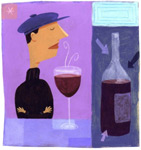![]()
![]() Read the article about a wine company and answer the following
questions.
Read the article about a wine company and answer the following
questions.
 |
|
|
|
![]() Read the article again and answer the questions.
Read the article again and answer the questions.
|
1. In the context of the article a label
is
a) un tipo de uva b) un contrato c) una etiqueta |

|
|
|
2. What is the main reason for Cartlidge &
Brown’s growth (crecimiento) last year?
|
||
|
3. What reason does Cartlidge give for
distributors buying more wine produced in the US?
|
||
|
4. Does Cartlidge think that the average
American expects a bottle of wine that costs $10 to taste good?
|
||
|
5. If you stick your nose in someone’s
business you
a) smell the product they make. b) interfere (entrometerse) in things that don’t concern you. c) know how to appreciate the good things in life. |
||
|
6. find words in the text that mean the
following:-
Example: to put – to support – high quality – sells – modernised - fast, quick - to have enough money to buy something - |
![]() Read the following text and choose the most suitable word.
Read the following text and choose the most suitable word.
|
In my opinion, being a wine snob is not about you're better than someone else just because you happen to know more about a particular subject. It is being passionate about something. It is being able to appreciate and identify quality. It is time out of our fast-paced, stressful lives, to stop and appreciate the good things in life. To smell the roses, or in this case, the grapes!
Wines with
acidity taste sharp, those with insufficient acidity taste
uninteresting and their flavour does not stay in the mouth for a long
time. Tannins contribute to the relationship of bitterness on the
tongue. If you've ever grape seeds, then you've tasted the dry bitterness of tannin.
Wine with too much tannin is unpleasantly bitter. The right amount of
tannin in wine brings all the flavours in the mouth. The various fruity flavours in wine contribute
to the sweetness we taste. It's trying to detect different fruit characteristics,
as berries, plums, apples, pears etc. |
La Mansión del Inglés. https://www.mansioningles.com
© Copyright La Mansión del Inglés C.B. Todos los derechos reservados.

¿Cómo puedo desactivar el bloqueo de anuncios en La Mansión del Inglés?




 Great
wine is a luxury that anyone can . The progress of technology in the last 3 decades has enabled
more and more of the world's wines to be of fairly
quality.
Great
wine is a luxury that anyone can . The progress of technology in the last 3 decades has enabled
more and more of the world's wines to be of fairly
quality.  Our
other senses are involved as . Our sight enjoys the colour and our sense of smell enjoys the
fragrances. Much of a wine's character is revealed only through the
aroma it . This adds richly to the dimensions found in wine.
Our
other senses are involved as . Our sight enjoys the colour and our sense of smell enjoys the
fragrances. Much of a wine's character is revealed only through the
aroma it . This adds richly to the dimensions found in wine.